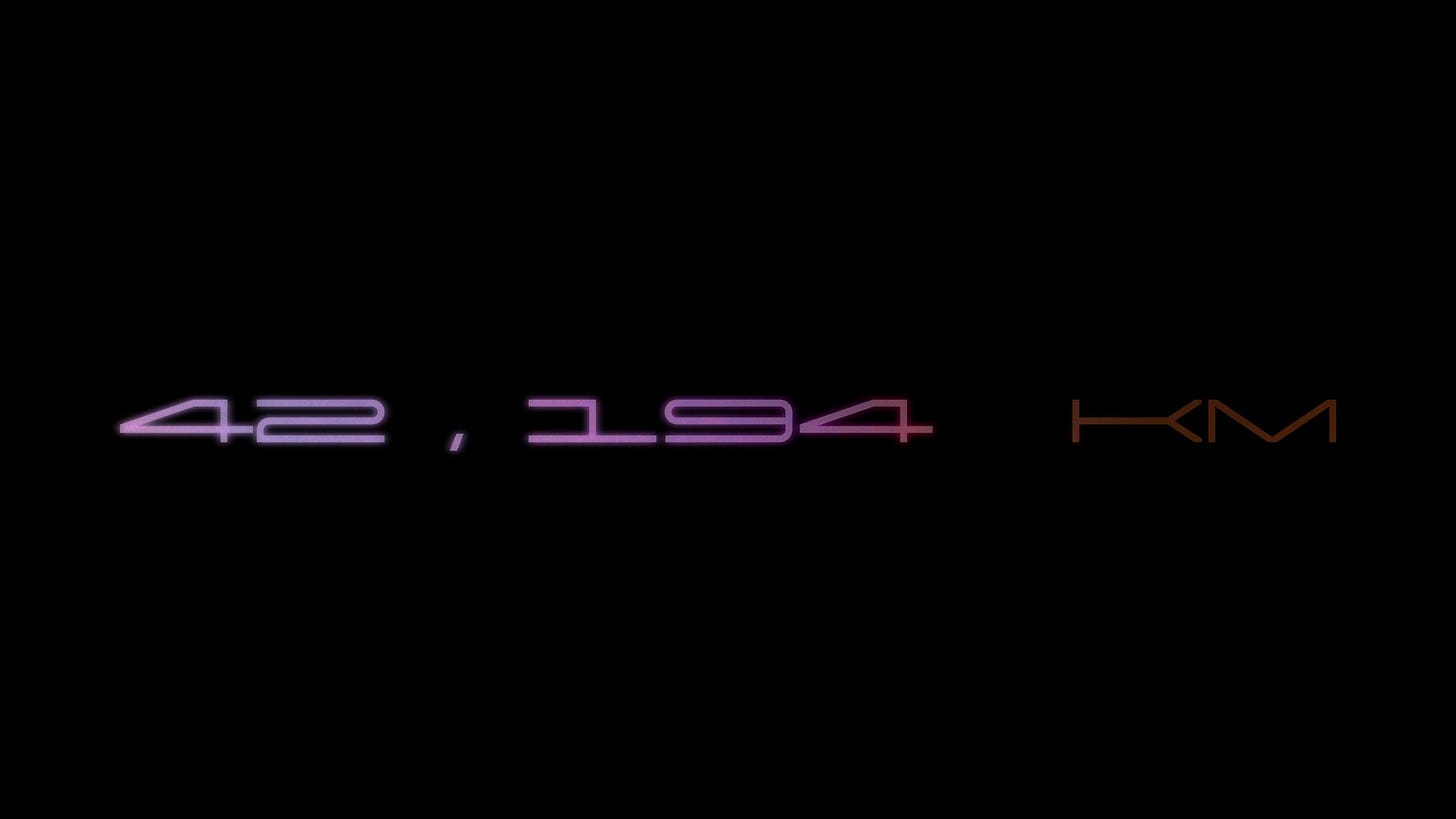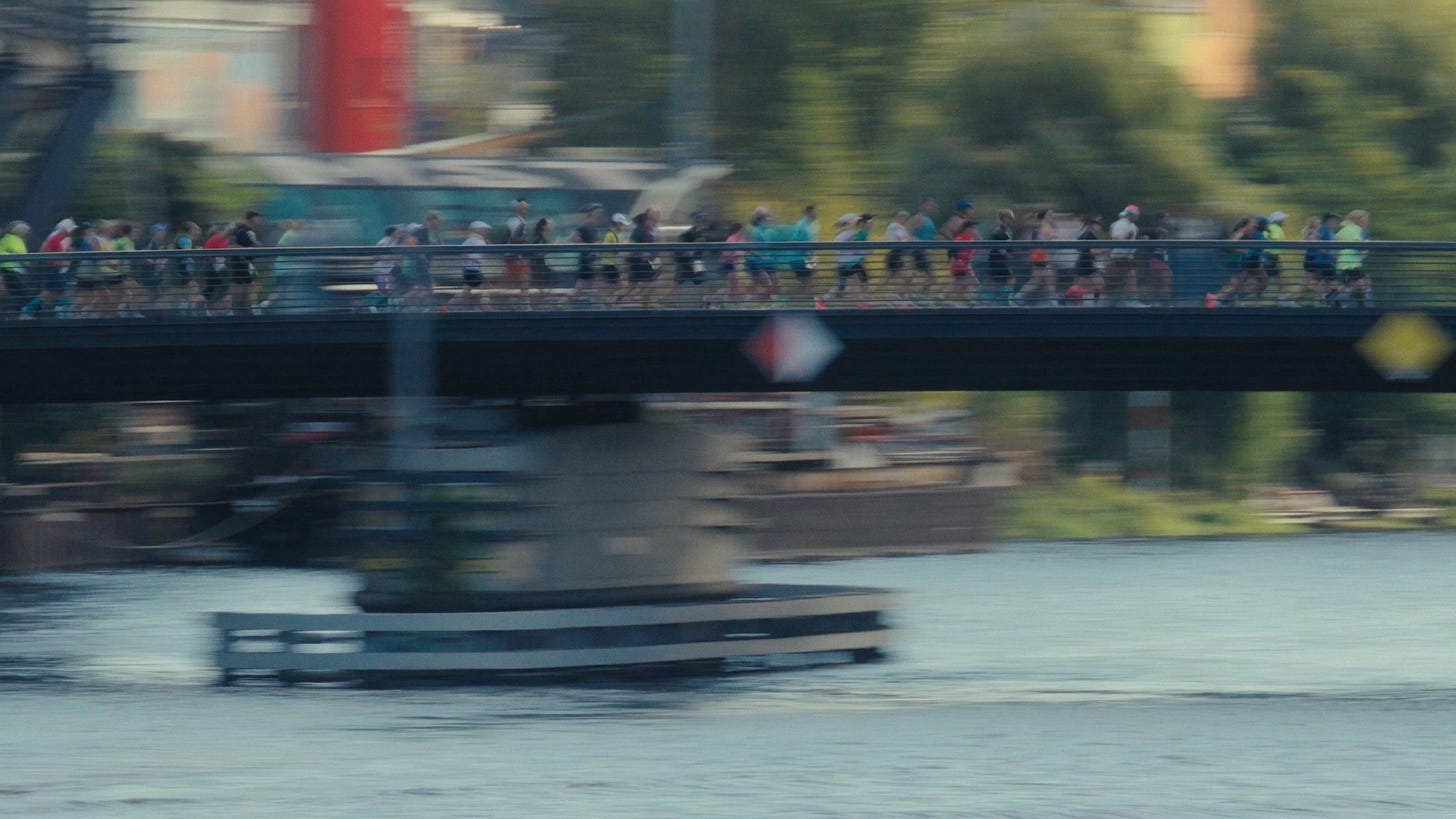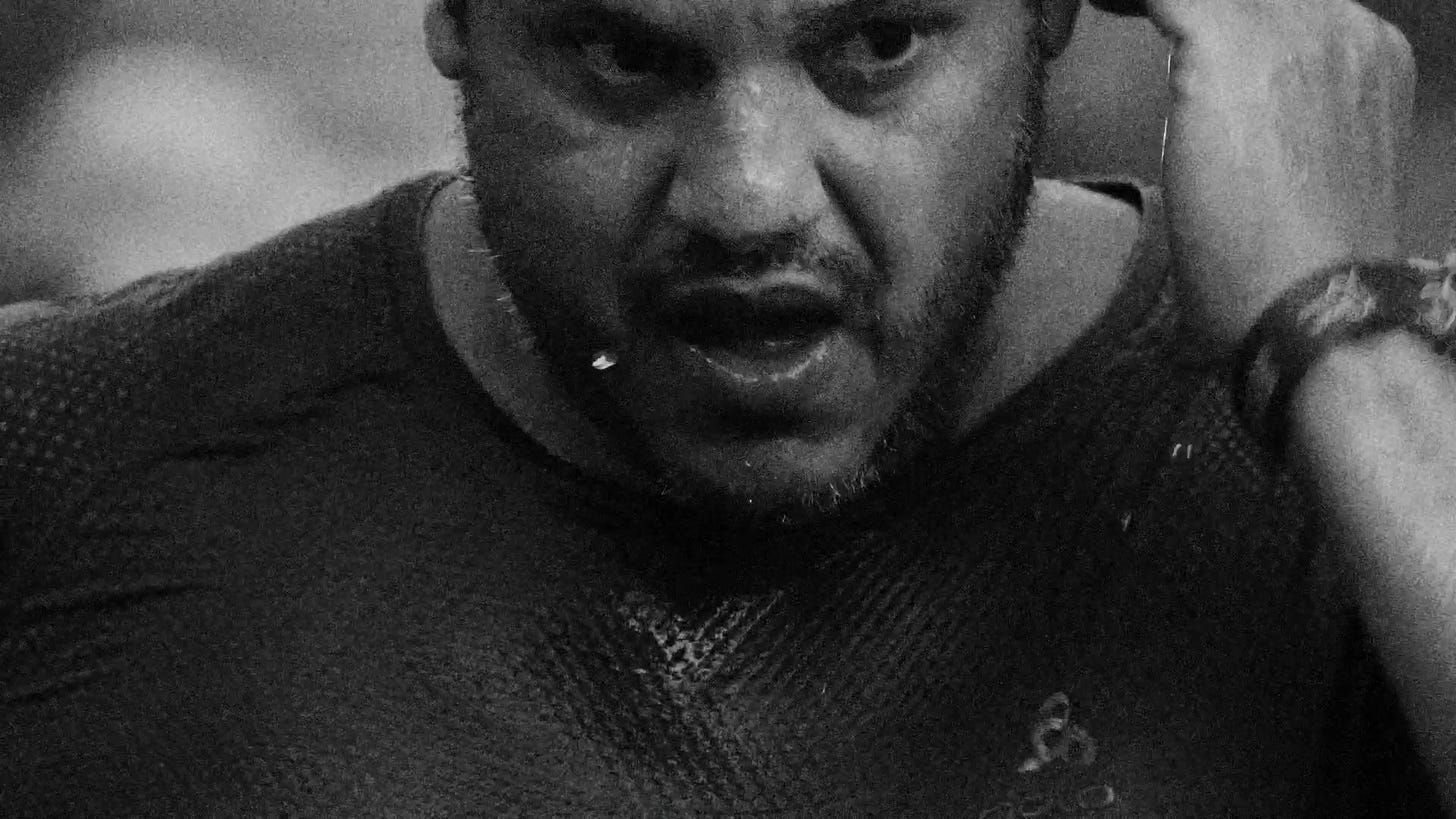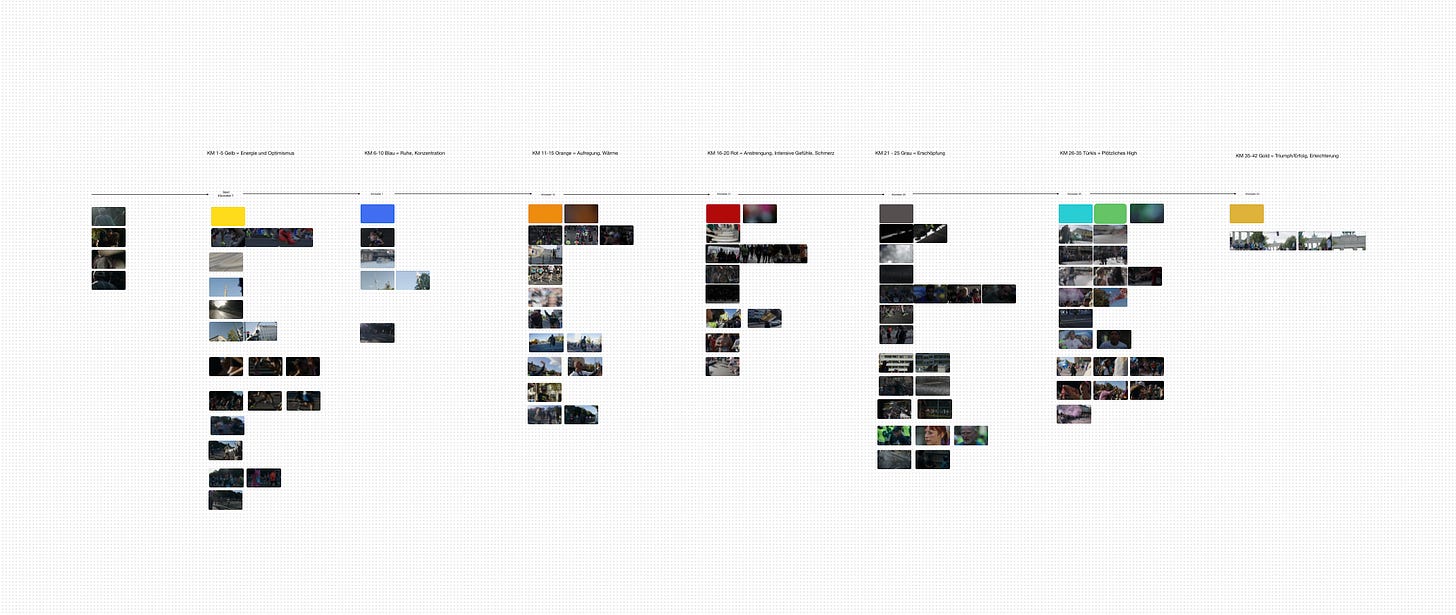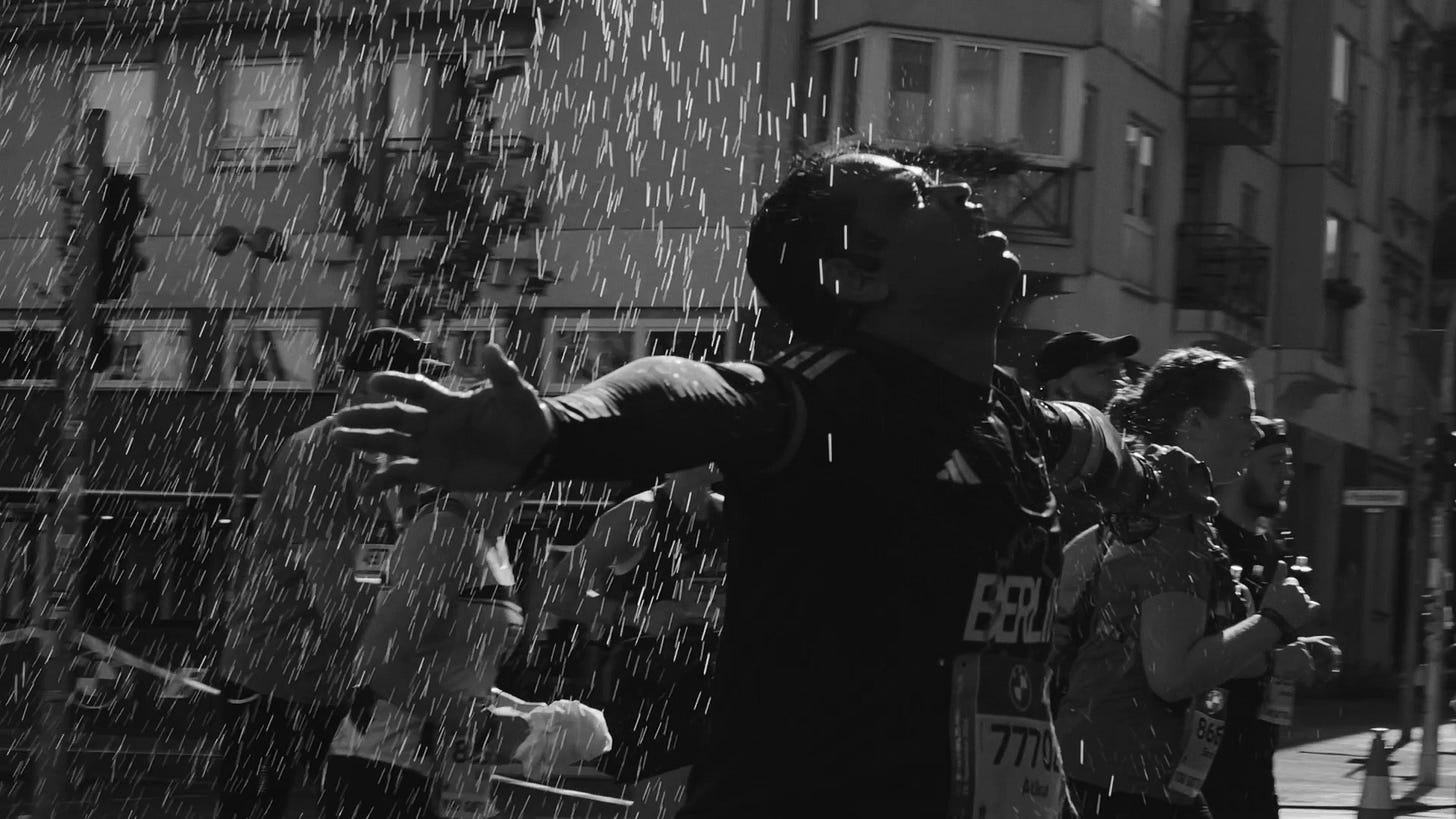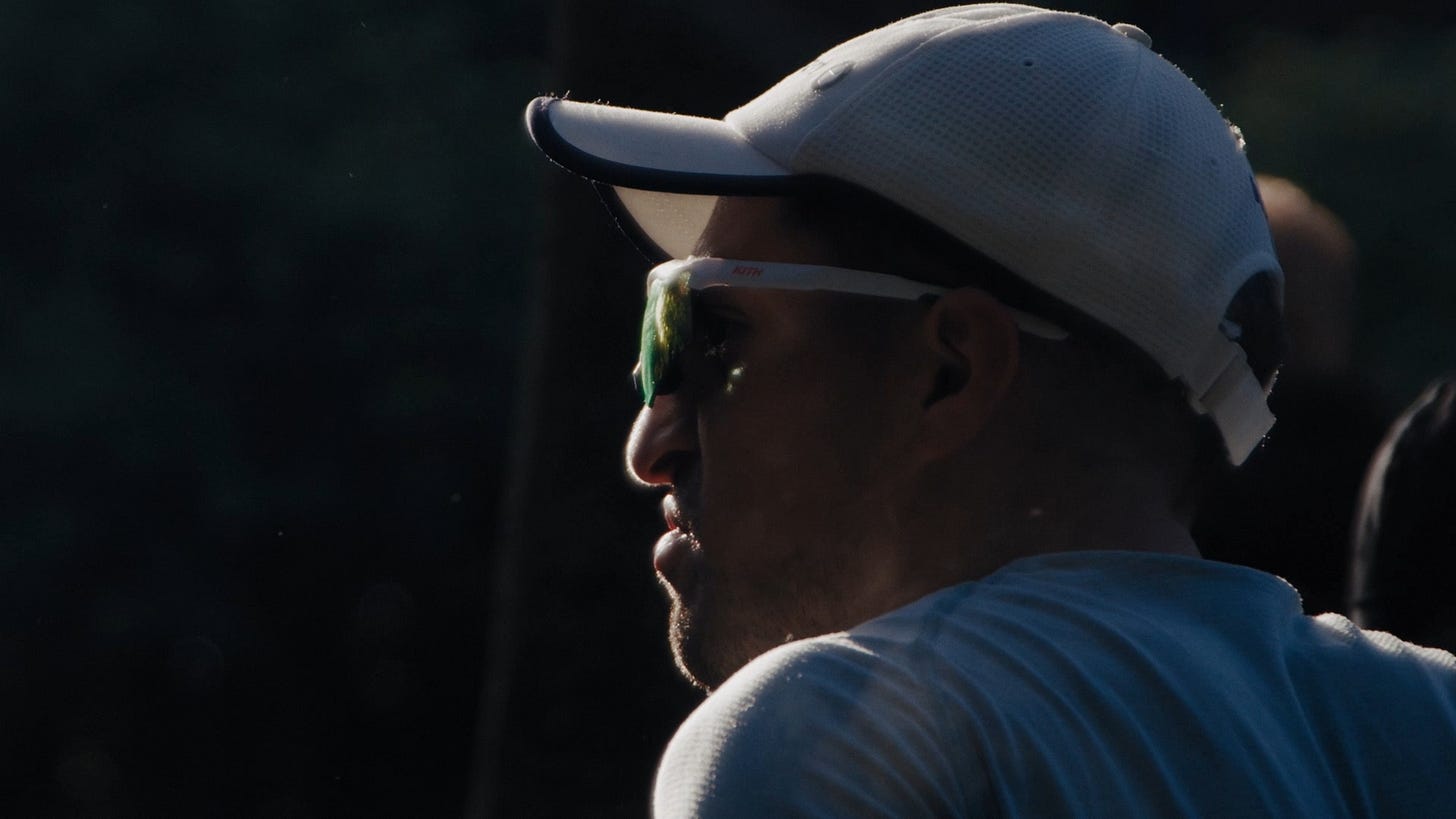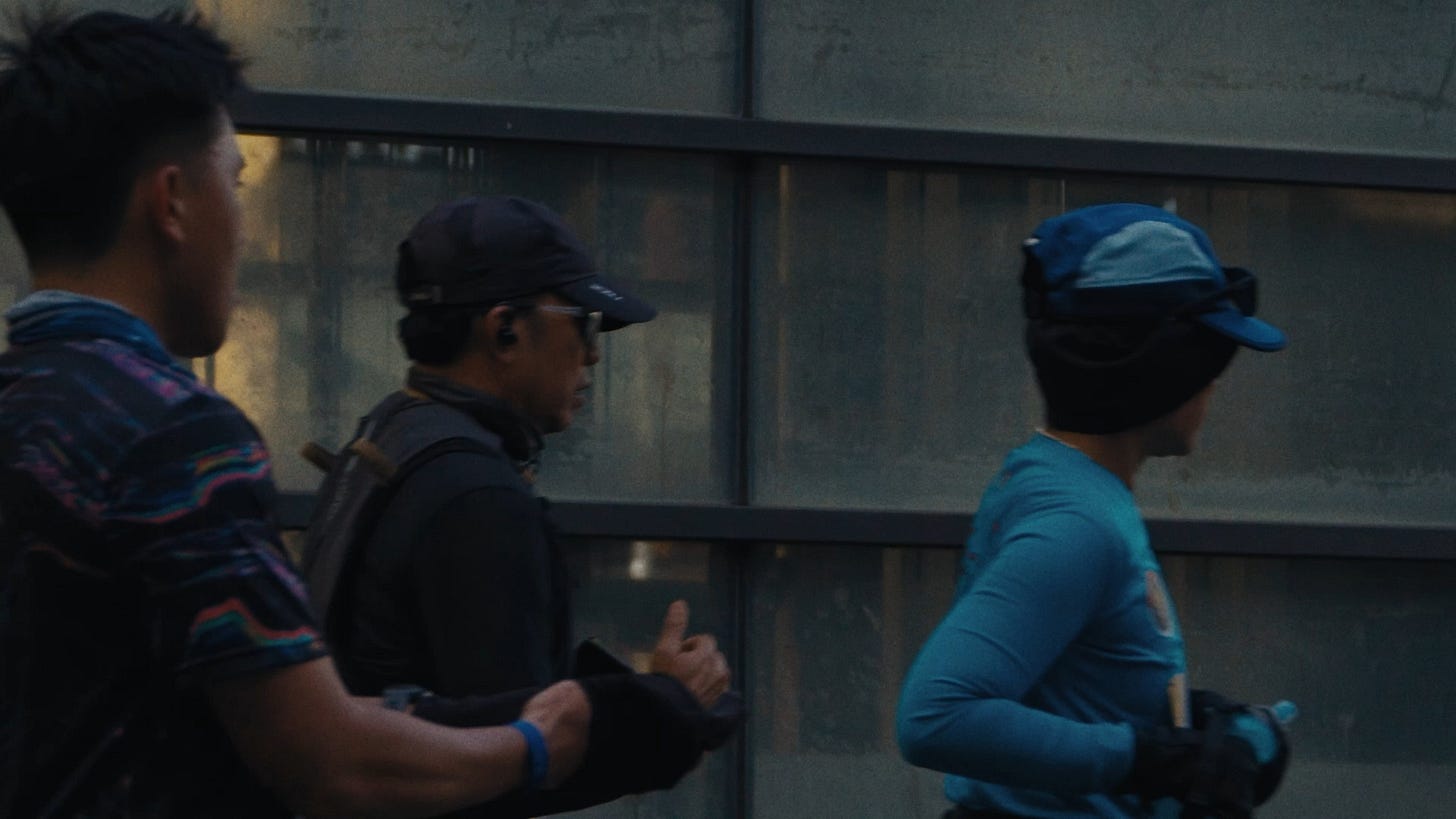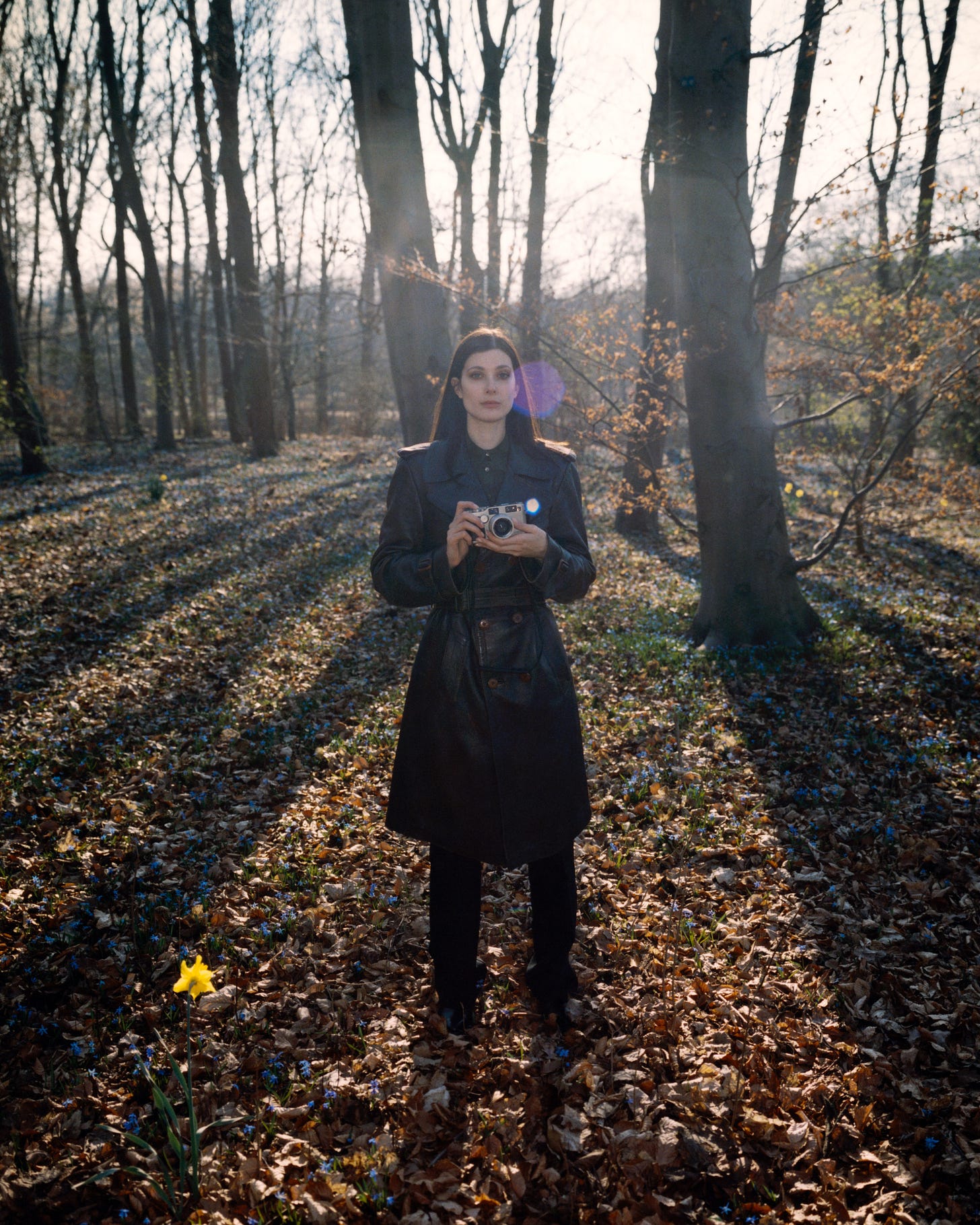Running Emotions
42,194 km Release, Tackling Procrastination and five questions for Larissa Hofmann
Dear Subscriber,
Welcome to my first official newsletter. To be honest, I was always insecure about my writing. It feels vulnerable to expose myself in written words; you cannot dial back, and sometimes it seems impossible to translate a thought that is also a feeling which is also changing into a few coherent sentences. But still, I want to give this a try.
I discovered Substack a while ago but didn't really get the hang of it at first, though I came to appreciate it more and more over time. I want to use this space not just to update you about my work, but also to give you insight into my creative process and what inspires me. My aim is to produce something that I would like to read myself. I might learn something in the process, and you might as well.
I am interested in visual worlds and how we create them, either through a lens or through imagination - this is a topic I want to explore. This relates to documentary and fashion photography as well as film, all areas I work in. I'm also fascinated by humans and why they do what they do, so my goal is to introduce an interesting person in each newsletter edition.
'Visions, Repetitions' - I chose this title because I see myself as a visual person and because I feel like art is so much an endless cycle of repeating and searching and slowly moving forward in the process.
I also want to share things that inspire me or keep me going, because I love reading recommendations for books, films, music, and thoughts - and maybe you do as well. But I am also curious: what would you like to hear more about?
For the first newsletter I’d like to share my process behind a personal film project I worked on for a few months and just released.
Current Project: 42,194 km
The Inspiration
I started running in 2020; locked inside my flat I fell in love with the easiness of the sport - taking on shoes and off you go. I ran a few half-marathons and started preparations for the 2023 Berlin Marathon but injured myself while training. I realised my body might not be made for such a long distance.
But there was one thing that really fascinated me in running: this incredible fight between your mind and body. At one point, you only want to give up, you feel pain and frustration and can't focus, and suddenly, the next moment you're in this incredible Runners High. You float, your feet fly, your body is a machine that fulfills its main purpose. You defeated that little voice that told you to stop, but for how long?
The Concept
I wanted to create a film about this inner fight (and in a way a little hero’s journey) every runner goes through. The idea came spontaneously when the Berlin Marathon 2024 came up. I used ChatGPT to develop the initial idea I had: initially I thought it would be realistic to find one image/scene representing each kilometre in the race. So 43 single scenes. I quickly realised this won't be feasible, even though ChatGPT enthusiastically agreed it would work out.
Another challenge that came up in the conceptual phase was, that it wouldn't be possible to communicate the emotional stages a runner goes through by finding representative images alone. I decided to summarize the marathon course into bigger phases, connected to common marathon lore and assign a color to each stage, drawing from the idea of color psychology and inspired by Jonathan Glazer's 'The Zone of Interest'. Each emotional stage is separated by a color plate that fades away - the color plate acting like a subliminal message or as a divider for each emotion.
For the sound, my long time collaborator Tobias Textor recorded ambiance sound along the course and created a custom sound piece, using percussion, foley and the recordings. The sound here was crucial as the camera wasn't able to convey a sense of first person point of view, so the sound had to be our main character.
Talking with Tobias and Cinematographer Philipp Lee Heidrich we defined six emotional stages we wanted to explore and find fitting scenes for:
Energy and Optimism in the beginning (Yellow)
Calm Concentration, after the start when you're finding your pace (Blue)
Excitement, when you realize it's going forward (Orange)
Painful Exhaustion, that sets in after a while (Red)
Desperation, when you only want to give up (Grey)
Runners High, as the final reward when you realize you're about to make it (Turquoise)
The Implementation
Philipp and I both filmed, while Tobias moved along the course with his recording equipment and sometimes the three of us met up. For me, it was the first time filming something that I intended to release, and a big challenge, to hold still but also to know when to actually stop a recording. I guess this is a common problem for photographers recording moving images. I was way too slow following all the runners. I liked the challenge to find unconventional angles and scenes, training the eye in a way.
It was intense, finding images that you wouldn't expect within a short time. Also, we quickly learned it was harder than anticipated to shake away the documentary perspective and find a subjective perspective. When bringing everything together in the edit we had to first find the most engaging scenes and then decide which ones have the most subjective standpoint. Which scenes hint to an emotion and which ones tell too much documentary? The rhythm of the scenes had to steer the emotional stages. The film had to have a rythm but also break this up to convey the harder emotional turmoil. Tobias used panting sounds in one of his first drafts, but then translated the panting of a runner into flute sounds.
I learned a lot about the challenges a documentary perspective adds to the edit process and I learned a lot about editing. I learned that texture is sometimes more important than an image that explains everything. This was very much a collaborative project between Philipp, Tobias and me and I learned that a good collaboration needs extensive feedback and structure. I’m also super grateful for Francis Qureshi and his agent Amy to see the potential in our project and do the grading.
You can watch the film here:
I would love to hear what you think!
Five Questions with Larissa Hofmann
Larissa and me met the first time in 2014 when we were both in New York, signed at the same modelling agency. We kept in touch over the years and both moved from modelling to photography, through different ways and different interests. I’ve always been a fan of her work, fascinated by her sensibility towards color and composition and how she maintains this playfulness and stringency throughout her work. We met in Berlin and had the chance to chat about her work:
Q: How did your perspective on representation and staging shift when you moved from modelling to photography?
A: When I first started modelling, everything moved so quickly that I didn’t give much thought to the overall composition of an image. Like most people in front of a camera, my focus naturally shifted to how I looked. Of course, I noticed composition, had my favourite photos, and felt drawn to certain photographers’ work, but more than anything, I was focused on the work itself - and happy if the client and team were pleased with the result.
Art played a central role in my last two years before the Abitur, so I had a foundation in composition, at least in theory. Whenever I travelled for work, I gravitated towards museums and galleries, drawn to the images around me. I sought them out whenever I could - I’ve always had a deep curiosity for the visual world. But it wasn’t until I started taking my own photos later in my modelling years that I truly began to see light and composition in a new way. Over time, I found myself instinctively imagining how I would approach a shot differently, and the more aware I became of this, the harder it was to continue modelling
Eventually, I made a conscious decision to step away from both being photographed and photographing myself, feeling the need to create a clear separation between the two.
Q: You often photograph nudes in unconventional perspectives. Q: What interests you about the body and the nude?
A: For me, the body is a crucial part of image composition. Photographing someone nude, in a sense, involves a deep level of trust—there’s a unique beauty in stripping away all layers (both physically and emotionally) and creating an intimate connection between the lens and the subject.
I never want to objectify or sexualise anyone. When I was photographed, especially by male photographers, I often felt like a role was being projected onto me. Whether nude or not, if I didn’t fit their vision exactly, I could sense their frustration. In those moments, I rarely recognised myself in the images, and I couldn’t help but wonder why I had given a part of myself to someone who wasn’t open to collaboration. It often felt like the result was more about their projection than a shared vision. I understand modelling involves playing a role to bring a concept to life, but I also believe a model should have space to express themselves within that role. That’s something I often felt was missing in those experiences.
When I photograph people, my goal is to create a space where they can simply be themselves. It’s a dialogue, not a one-sided decision. I approach each person with openness and acceptance, aiming to capture them in their truest form.
Q: What I really like about your images is the use of household objects and how you play around with dioramas. What’s the meaning or story behind those objects for you?
A: I can’t quite explain why I’m drawn to everyday objects and give them a new perspective - it’s something that just comes naturally. As a child I was always crafting, drawing, and making up little stories, lost in my own world. You don’t have to travel far to discover something new; often, the most interesting things are right in front of you, in places you’ve seen a hundred times. You might overlook them until one day something catches your eye in a completely different way. I enjoy transforming what’s around me, creating something unique from ordinary objects. There’s a playful quality to it that feels true to me. I like how these elements contrast with the more direct, raw aspects of my work - it’s a balance that feels natural, not forced.
Q: How do you balance your artistic vision with commercial requirements?
A: Every commercial project is different, so I approach each one based on what’s needed and how I can bring my own artistic vision to it. Some projects involve creative directors and stylists who add their input and I really enjoy that collaborative aspect.
I have certain elements I need in every project, though how they show up can vary. Sometimes they’re more obvious and other times they’re more subtle. I like when a story has rhythm and tension, or when there are elements that leave people second-guessing. It keeps things interesting. I enjoy the planning and research that goes into shoots, but I’ve learned that pushing your vision without compromise doesn’t always work. Staying flexible and open-minded is key; coming in with a rigid mindset can definitely get in the way. To keep creating, I’ve found I need a balance between personal work that inspires me and commercial projects where I help bring other people’s ideas to life.
Q: What do you want to explore in the future?
A: I recently joined a new agency, so after months of managing everything on my own, I finally feel like I can step back and reassess what I want to do creatively. That side of things had to take a backseat while I focused on the admin and logistics of handling my own bookings and commercial work - so this feels like a new chapter.
The past few weeks have been a kind of research phase, which I enjoy immensely. I’ve taken a couple of smaller trips, seen some shows, had great conversations - both with people I haven’t seen in a while and with new acquaintances. Lots of walks and solitude. Had some nights out and have hidden away to read, reflect, and watch things. I’ve been using this time to think about personal projects and ask myself: What do I want to do next?
Monthly Discoveries
1. 'Conversations with Kiarostami' by Godfrey Cheshire
Short interviews Film Critic Cheshire led with the Iranian Director Abbas Kiarostami, structured by the time of appearance of each film. Kiarostami doesn't take himself seriously at all, shares deep wisdom and at the same time sounds like an eternal seeker. Very inspiring. It felt validating to hear about the struggles and small stories that often get overlooked in more traditional film analysis.
2. 'La Cocina' by Alonso Ruizpalacios
Shit is about to go down in a Times Square Restaurant. A film that didn't receive enough attention in my opinion. It's funny, claustrophobic, sad, disgusting, unexpected. I love how magic realism is used in such a nonchalant way. The kitchen becomes a universe of its own, with rules and hierarchies that mirror our larger society. Definitely worth seeking out. 4/5! Also I love this wave of Magic Realism in Cinema at the moment.
3. Gratitude Diary
I started a gratitude diary to tackle procrastination - and it works. Maybe this newsletter is also a result of it. Each morning I write down the things I achieve and I ask my inner avoider and inner creative what they actually need from me today. At the end of the work-day, I reflect what worked out, what didn't, and write what I felt grateful for. It's helped me recognize patterns in my creative blocks and find gentler ways to work through them. I think this newsletter is a direct result of this practice.
Looking Forward
What would you like to see explored in future editions? Feel free to reply directly to this email or comment on Substack - I'd love to hear from you.
Until next time,
Bastian


